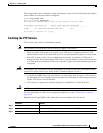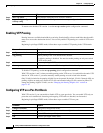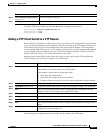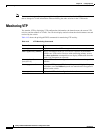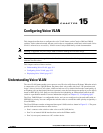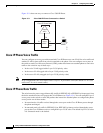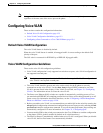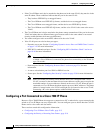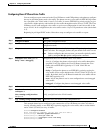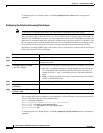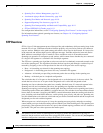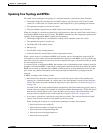
15-5
Catalyst 2960 and 2960-S Switch Software Configuration Guide
OL-8603-09
Chapter 15 Configuring Voice VLAN
Configuring Voice VLAN
Configuring Cisco IP Phone Voice Traffic
You can configure a port connected to the Cisco IP Phone to send CDP packets to the phone to configure
the way in which the phone sends voice traffic. The phone can carry voice traffic in IEEE 802.1Q frames
for a specified voice VLAN with a Layer 2 CoS value. It can use IEEE 802.1p priority tagging to give
voice traffic a higher priority and forward all voice traffic through the native (access) VLAN. The Cisco
IP Phone can also send untagged voice traffic or use its own configuration to send voice traffic in the
access VLAN. In all configurations, the voice traffic carries a Layer 3 IP precedence value (the default
is 5).
Beginning in privileged EXEC mode, follow these steps to configure voice traffic on a port:
This example shows how to configure a port connected to a Cisco IP Phone to use the CoS value to
classify incoming traffic, to use IEEE 802.1p priority tagging for voice traffic, and to use the default
native VLAN (VLAN 0) to carry all traffic:
Switch# configure terminal
Enter configuration commands, one per line. End with CNTL/Z.
Switch(config)# interface gigabitethernet0/1
Switch(config-if)# mls qos trust cos
Switch(config-if)# switchport voice vlan dot1p
Switch(config-if)# end
Command Purpose
Step 1
configure terminal Enter global configuration mode.
Step 2
interface interface-id Specify the interface connected to the phone, and enter interface
configuration mode.
Step 3
mls qos trust cos Configure the interface to classify incoming traffic packets by using the
packet CoS value. For untagged packets, the port default CoS value is used.
Note Before configuring the port trust state, you must first globally enable
QoS by using the mls qos global configuration command.
Step 4
switchport voice vlan {vlan-id |
dot1p | none | untagged}}
Configure how the Cisco IP Phone carries voice traffic:
• vlan-id—Configure the phone to forward all voice traffic through the
specified VLAN. By default, the Cisco IP Phone forwards the voice
traffic with an IEEE 802.1Q priority of 5. Valid VLAN IDs are
1 to 4094.
• dot1p—Configure the phone to use IEEE 802.1p priority tagging for
voice traffic and to use the default native VLAN (VLAN 0) to carry all
traffic. By default, the Cisco IP Phone forwards the voice traffic with an
IEEE 802.1p priority of 5.
• none—Allow the phone to use its own configuration to send untagged
voice traffic.
• untagged—Configure the phone to send untagged voice traffic.
Step 5
end Return to privileged EXEC mode.
Step 6
show interfaces interface-id
switchport or
show running-config interface
interface-id
Verify your voice VLAN entries.
Verify your QoS and voice VLAN entries.
Step 7
copy running-config startup-config (Optional) Save your entries in the configuration file.



